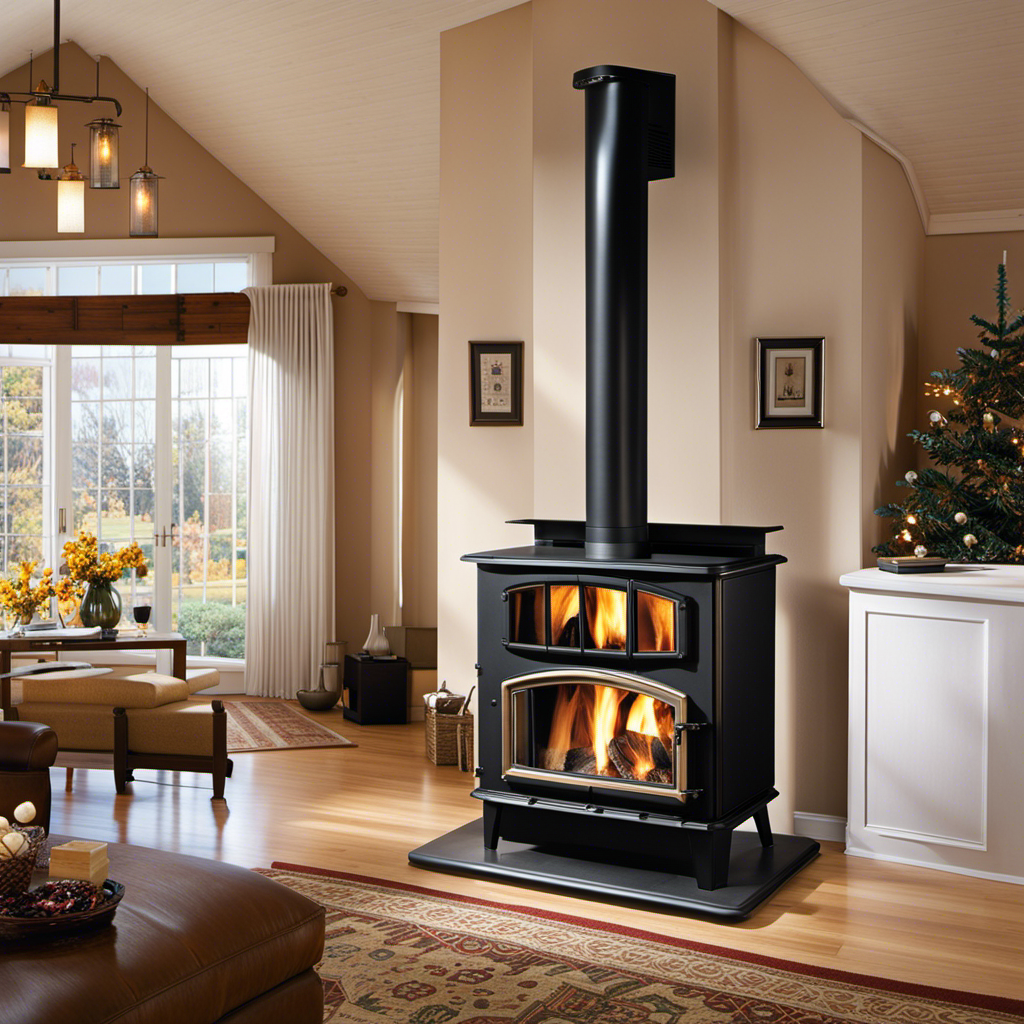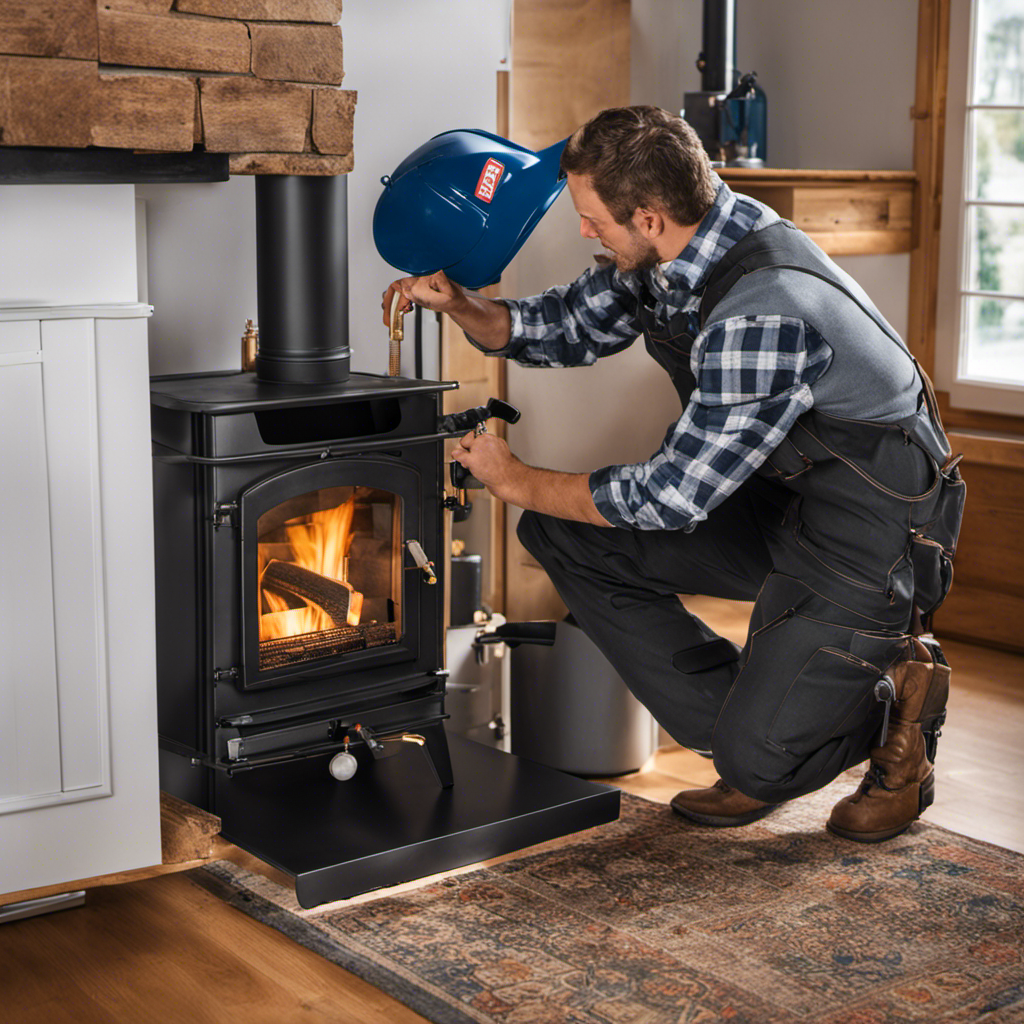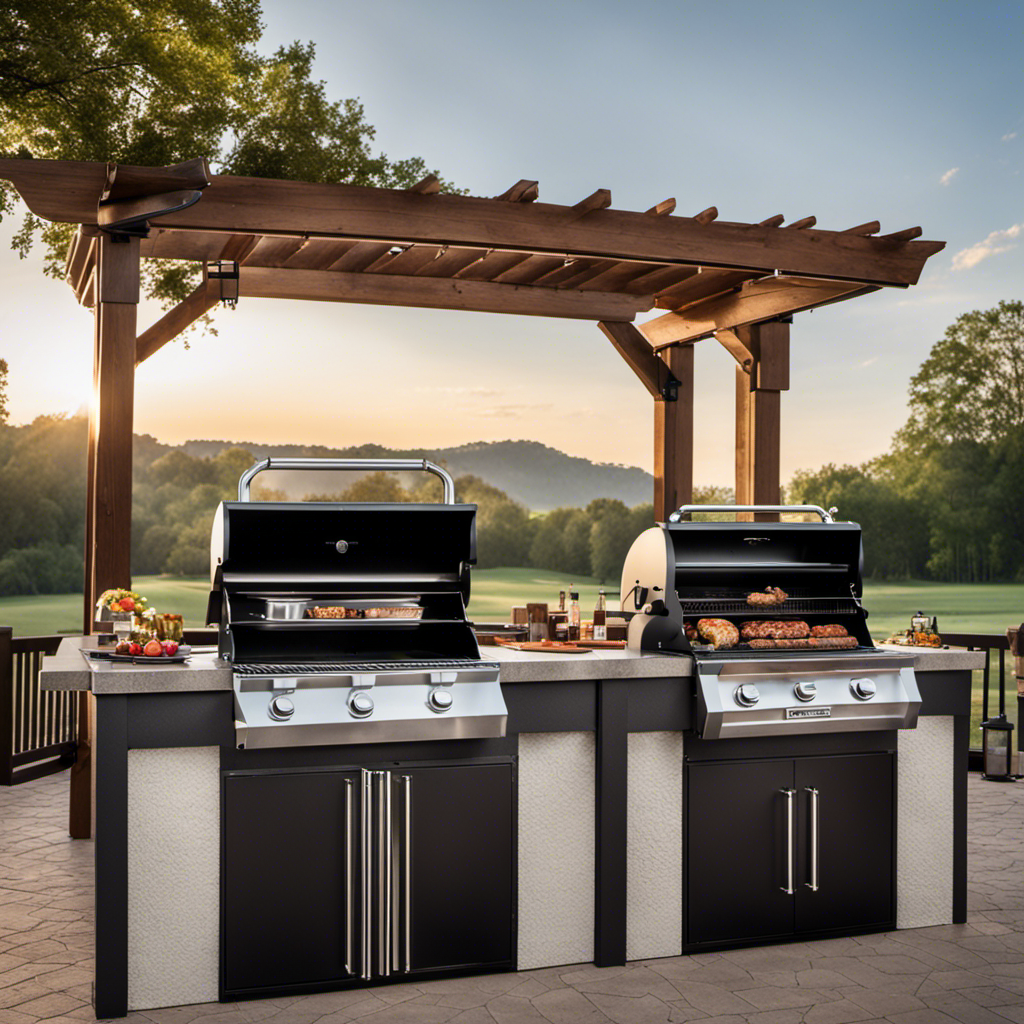As homeowners, we continuously seek efficient and eco-friendly heating options. This is why pellet stoves are so attractive. Utilizing compressed wood or biomass pellets as fuel, these sophisticated units present an environmentally friendly choice compared to conventional heating approaches.
But there’s more to pellet stoves than just heat. The type and quality of pellets can create unique aromas, from the scent of sawdust to the sweet fragrance of cooking.
In this article, we’ll uncover the aromatic secrets of pellet stoves and share tips for optimal performance and minimal odors.
Key Takeaways
- Different types of pellets used in pellet stoves emit different smells, such as wet wood, burning foods mixed with wood, or sweet smells.
- Proper maintenance, ventilation, and cleaning are essential to reduce smoke and prevent the smell of burning wood from entering the house.
- Pellet stove maintenance is crucial to ensure proper functioning and reduce the risk of smoke and other problems.
- Pellet stoves offer numerous benefits, including high efficiency, low pollution, affordability, convenient controls, and a consistent heat output.
Types of Pellets and Their Aromas
We have found that different types of pellets emit distinct aromas when burned in pellet stoves. Factors affecting pellet aroma include the type of wood used, the moisture content of the pellets, and any additives or binders present in the pellets.
Differentiating between pellet smells can be helpful in determining the quality and suitability of the pellets for your stove. Sawdust pellets have a recognizable smell of slightly wet wood, while organic pellets emit a smell similar to burning foods mixed with wood. Cooking pellets, like cherry or hickory woods, have a sweet smell and aren’t suitable for pellet stoves.
Hardwood pellets tend to smoke more and can smell like burning wood, whereas softwood pellets have a light woody smell and produce almost no smoke. It’s important to consider these factors when choosing pellets for your pellet stove to ensure a pleasant aroma and optimal performance.
Tips for Reducing Smoke Emissions
Reducing smoke emissions is important for maintaining the efficiency and cleanliness of our pellet stove. To achieve this, it’s essential to follow a pellet stove maintenance checklist and troubleshoot any smoke issues that arise.
Regular cleaning and inspection of the stove, vents, and ash are necessary to prevent smoke and other problems. Ensure proper ventilation by keeping the pellet stove well ventilated, cleaned, and supplied with a constant exit to prevent smoke from escaping into the house.
Check for carbon monoxide risks by ensuring fresh air intake. If smoke is still entering the house, it’s recommended to have the stove inspected. Additionally, be mindful of pellet quality, moisture levels, proper oxygen supply, and the condition of the electric starter.
Importance of Regular Pellet Stove Maintenance
Regular maintenance is crucial for ensuring the efficiency and longevity of our pellet stove. Neglecting proper maintenance can lead to various problems with pellet stoves. Here are some tips for pellet stove maintenance:
-
Cleaning and Inspection: Regularly clean the stove, vents, and ash to prevent smoke and other issues. Inspect the auger, igniter, and other components for any signs of damage or wear.
-
Fuel Quality: Use high-quality pellets with low moisture content to minimize smoke and maximize efficiency. Avoid using cooking or specialized pellets that can produce unfamiliar smells.
Common problems with pellet stoves include auger jamming, combustion issues due to poor quality pellets, and ash buildup in the burn pot. Regular maintenance helps identify and address these issues before they escalate.
Understanding the Basics of Pellet Stoves
When it comes to heating our home efficiently, understanding the basics of how pellet stoves work is essential.
Pellet stoves are a popular and efficient heating device that uses compressed wood or biomass pellets as fuel.
Compared to traditional wood stoves, pellet stoves have several pros and cons.
One advantage of pellet stoves is their higher heating efficiency, providing a cost-effective and eco-friendly heating solution. They also produce less pollution and offer convenient controls.
However, pellet stoves may emit a slight smell of burning wood during operation. The impact of pellet stove emissions on indoor air quality can vary depending on the quality and type of pellets used. Proper ventilation and regular cleaning can help minimize any potential odors and ensure a healthy indoor environment.
Benefits of Pellet Stoves Compared to Kerosene Heaters
Compared to kerosene heaters, we find that pellet stoves offer a more environmentally friendly and efficient heating solution.
-
Pellet stoves minimize environmental impact by using compressed wood or biomass pellets as fuel, which are renewable and produce fewer emissions compared to kerosene.
-
These pellets are readily available and affordable, making them a sustainable option for heating.
-
Pellet stoves also improve air quality by producing less pollution compared to traditional wood stoves or kerosene heaters.
-
In addition to being eco-friendly, pellet stoves are highly efficient and offer a consistent and adjustable heat output.
-
They have a higher heating efficiency than kerosene heaters, ensuring that less energy is wasted and more heat is provided.
-
By using a hopper for continuous fuel supply, pellet stoves eliminate the need for regular refilling, providing convenience and ease of use.
Factors Affecting the Aroma of Pellet Stoves
As homeowners, we can appreciate how different factors can influence the smell produced by our pellet stoves. Factors affecting pellet stove aroma can include the type of pellets used, such as sawdust pellets which have a recognizable smell of slightly wet wood, or organic pellets that emit a smell similar to burning foods mixed with wood.
Additionally, the type of wood used in the pellets can also impact the aroma. For example, cooking pellets like cherry or hickory woods have a sweet smell but aren’t suitable for pellet stoves.
Tips for enhancing pellet stove aroma include using high-quality pellets with low moisture content, keeping the stove well-maintained and properly ventilated, and using specialized pellets designed for heating purposes.
Proper Ventilation and Odor Control for Pellet Stoves
When it comes to proper ventilation and odor control for pellet stoves, there are several techniques and options available. Ventilation plays a crucial role in ensuring that any smoke or odor produced by the stove is properly expelled from the house. Here are a few key techniques to consider:
-
Maintain a well-ventilated space: Ensure that the room where the pellet stove is located has adequate ventilation, such as open windows or an exhaust fan, to allow for proper air circulation.
-
Use scent neutralizing options: To further control any lingering odors, consider using scent neutralizing products or techniques, such as using odor-absorbing materials or installing air purifiers.
It’s important to note that proper ventilation and odor control go hand in hand in creating a comfortable and odor-free environment when using a pellet stove. By implementing these techniques and options, you can enjoy the warmth and efficiency of your pellet stove without any unpleasant smells.
Choosing the Right Pellets for Minimizing Odors
To minimize odors, we should carefully select the type and quality of pellets used in our pellet stoves. The choice of pellet quality directly affects the odors emitted during combustion. Pellets with high moisture content tend to produce more smoke and odor. It’s important to choose pellets that have been properly dried and have a low moisture content. Moisture in pellets can lead to increased soot and smoke, resulting in unpleasant odors in the house.
Troubleshooting Common Issues With Pellet Stoves
By understanding common issues and how to troubleshoot them, we can ensure the proper functioning of our pellet stoves. When it comes to troubleshooting pellet stoves, two common issues that often arise are problems with the auger and issues with the igniter.
Troubleshooting Auger Problems:
- Check for any obstructions in the auger tube that may be preventing the pellets from feeding properly.
- Inspect the auger motor and ensure it’s functioning correctly.
- Verify that the auger is properly aligned and not loose or worn.
- Clean the hopper to remove any debris that may be causing the auger to jam.
Dealing with Igniter Issues:
- Check the connection between the igniter and the power source to ensure it’s secure.
- Inspect the igniter for any signs of damage or wear.
- Clean the igniter to remove any ash or buildup that may be affecting its performance.
- Replace the igniter if it isn’t heating up properly.
Enhancing the Aromatic Experience of Pellet Stoves
As enthusiasts of pellet stove heating, we can enhance our aromatic experience by using high-quality pellets with natural additives like herbs or spices. Adding these fragrant elements to our pellets can create a delightful scent that fills our homes while the stove is in operation.
When choosing herbs or spices to enhance the fragrance, it’s important to select those that are safe for combustion and won’t produce harmful fumes. Lavender, rosemary, and cinnamon are popular choices that not only add a pleasant aroma but also offer additional benefits such as relaxation and improved air quality.
It’s recommended to blend the herbs or spices with the pellets before loading them into the hopper. This allows for an even distribution of the fragrance throughout the burning process, resulting in a more enjoyable and aromatic experience.
How Do Pellet Stove Igniters Affect the Aromatic Output of Pellet Stoves?
Pellet stove igniters secrets unlocked: Pellet stove igniters play a crucial role in determining the aromatic output of pellet stoves. By igniting the pellets efficiently and at the right temperature, these igniters ensure a clean and consistent burn, enhancing the release of delightful aromas. With advanced technology and precise engineering, pellet stove igniters unlock the secrets to maximize the aromatic experience while minimizing emissions and maintaining energy efficiency.
What Does the Ignition System of a Pellet Stove Have to Do with Its Aroma?
When it comes to the aroma of a pellet stove, the pellet stove igniter secrets unlocked play a crucial role. The ignition system is responsible for starting the combustion process, which ultimately impacts the quality and scent of the burning pellets. Understanding the igniter secrets can help enhance the overall experience.
Frequently Asked Questions
Can I Use Cooking Pellets, Like Cherry or Hickory Woods, in My Pellet Stove?
Using cooking pellets, like cherry or hickory woods, in a pellet stove isn’t recommended. While they may have a sweet smell and are commonly used for smoking meat, they aren’t suitable for pellet stoves.
Cooking pellets can produce unfamiliar smells and may not burn efficiently, leading to issues with combustion and increased smoke.
It’s best to use pellets specifically designed for heating purposes in pellet stoves for optimal performance and minimal odor.
How Can I Prevent the Accumulation of Ash in the Bucket Underneath the Burning Pellets?
To prevent the accumulation of ash in the bucket underneath the burning pellets, it’s important to ensure proper maintenance of the pellet stove.
Regular cleaning and inspection of the stove, vents, and ash are necessary. Cleaning the burn pot and removing ash buildup will help enhance the performance of the stove and prevent the release of excess smoke.
Additionally, using high-quality pellets with low moisture content can minimize ash production and improve the overall aroma of the pellet stove.
What Are the Potential Dangers of Carbon Monoxide When Smoke Enters the House?
What are the potential dangers of carbon monoxide when smoke enters the house?
Carbon monoxide can be a dangerous gas that’s released when smoke from a pellet stove enters the house. It’s odorless, colorless, and can be deadly if inhaled in high concentrations.
To prevent this, it’s important to keep the pellet stove well ventilated and ensure proper maintenance, including cleaning vents and removing ash. Regular inspection and fresh air intake are also crucial to reducing the risk of carbon monoxide poisoning.
What Are Some Common Issues That Can Cause Smoldering Pellets and Increased Smoke in Older Pellet Stoves?
Common causes of smoldering pellets and increased smoke in older pellet stoves can include:
- A faulty electric starter
- Inadequate oxygen supply
- Ash accumulation in the burn pot
Troubleshooting tips for pellet stove maintenance include:
- Regular cleaning and inspection of the stove, vents, and ash
- Ensuring proper ventilation and fresh air intake
Understanding these common issues and taking necessary maintenance steps can help reduce smoke and ensure the efficient operation of older pellet stoves.
Are There Any Specific Techniques or Products That Can Enhance the Aroma of Pellet Stoves?
There are several techniques and products available to enhance the aroma of pellet stoves.
One method is to add aromatic wood pellets, such as apple or cherry, to the fuel mix. These pellets release a pleasant scent while burning.
Another option is to use scented pellet stove additives, which can be added directly to the fuel. These additives come in a variety of fragrances, allowing you to customize the aroma.
It’s important to note that these techniques should be used in well-ventilated areas and with caution to prevent any potential safety hazards.
Conclusion
As we conclude our exploration into the aromatic world of pellet stoves, we’re left with a sense of anticipation. The secrets behind the scents emitted by these innovative devices have been unveiled, and we now have a deeper understanding of how to enhance our overall experience.
By choosing the right pellets, maintaining our stoves regularly, and ensuring proper ventilation, we can create a truly aromatic environment that brings warmth, efficiency, and eco-friendliness into our homes.
So, embrace the scent and embrace the future of heating.
Growing up surrounded by the vast beauty of nature, Sierra was always drawn to the call of the wild. While others sought the comfort of the familiar, she ventured out, embracing the unpredictable and finding stories in the heartbeat of nature.
At the epicenter of every remarkable venture lies a dynamic team—a fusion of diverse talents, visions, and passions. The essence of Best Small Wood Stoves is crafted and refined by such a trio: Sierra, Logan, and Terra. Their collective expertise has transformed the platform into a leading authority on small wood stoves, radiating warmth and knowledge in equal measure.











